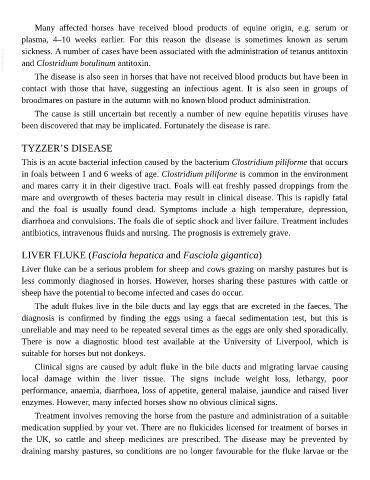Page 789 - The Veterinary Care of the Horse
P. 789
Many affected horses have received blood products of equine origin, e.g. serum or
plasma, 4–10 weeks earlier. For this reason the disease is sometimes known as serum
VetBooks.ir sickness. A number of cases have been associated with the administration of tetanus antitoxin
and Clostridium botulinum antitoxin.
The disease is also seen in horses that have not received blood products but have been in
contact with those that have, suggesting an infectious agent. It is also seen in groups of
broodmares on pasture in the autumn with no known blood product administration.
The cause is still uncertain but recently a number of new equine hepatitis viruses have
been discovered that may be implicated. Fortunately the disease is rare.
TYZZER’S DISEASE
This is an acute bacterial infection caused by the bacterium Clostridium piliforme that occurs
in foals between 1 and 6 weeks of age. Clostridium piliforme is common in the environment
and mares carry it in their digestive tract. Foals will eat freshly passed droppings from the
mare and overgrowth of theses bacteria may result in clinical disease. This is rapidly fatal
and the foal is usually found dead. Symptoms include a high temperature, depression,
diarrhoea and convulsions. The foals die of septic shock and liver failure. Treatment includes
antibiotics, intravenous fluids and nursing. The prognosis is extremely grave.
LIVER FLUKE (Fasciola hepatica and Fasciola gigantica)
Liver fluke can be a serious problem for sheep and cows grazing on marshy pastures but is
less commonly diagnosed in horses. However, horses sharing these pastures with cattle or
sheep have the potential to become infected and cases do occur.
The adult flukes live in the bile ducts and lay eggs that are excreted in the faeces. The
diagnosis is confirmed by finding the eggs using a faecal sedimentation test, but this is
unreliable and may need to be repeated several times as the eggs are only shed sporadically.
There is now a diagnostic blood test available at the University of Liverpool, which is
suitable for horses but not donkeys.
Clinical signs are caused by adult fluke in the bile ducts and migrating larvae causing
local damage within the liver tissue. The signs include weight loss, lethargy, poor
performance, anaemia, diarrhoea, loss of appetite, general malaise, jaundice and raised liver
enzymes. However, many infected horses show no obvious clinical signs.
Treatment involves removing the horse from the pasture and administration of a suitable
medication supplied by your vet. There are no flukicides licensed for treatment of horses in
the UK, so cattle and sheep medicines are prescribed. The disease may be prevented by
draining marshy pastures, so conditions are no longer favourable for the fluke larvae or the

